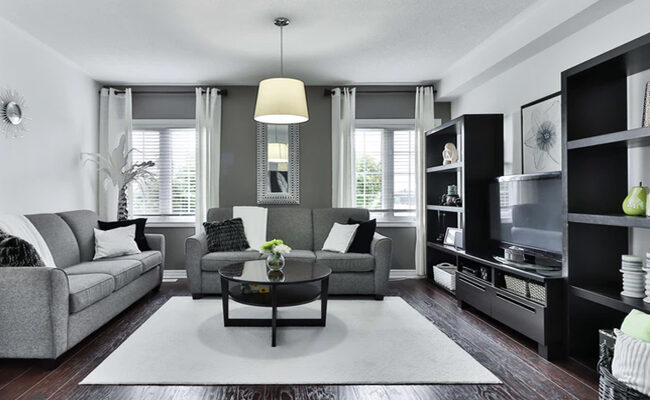
Have a small living room? There are countless design tricks that promise to make your space feel bigger, but do they really work? Here’s a compilation of some proven design tricks that will certainly make your living room feel larger, no matter how small it actually is.
1. Let In the Light
Anytime you’re trying to enlarge a small space, lighting should be the first thing on your list. This trick is actually threefold. For starters, you need to look to natural light sources and make sure they aren’t blocked. Oversized furniture sitting partially in front of a window is a big mistake. Likewise, curtains that you can’t pull back easily need to go.
Next, think of how you can complement the natural lighting with artificial lighting. Opt for natural white LED bulbs so they brighten the room at all hours, ideally being dimmable for the late evening hours and when you’re watching TV. Make sure you have lighting in corners, whether or not you have an overhead light you can turn on.
The third part of this trick involves paint colors. You’ve likely heard that painting your walls white will make a room feel bigger, but white can be boring. If you can paint, opt for a light earthy shade or muted color, like a soft lavender or muted sage.
2. Keep the Style Simple
There’s nothing wrong with a pop of color, but be mindful of brightly colored furniture. Anything bright will bring attention to itself, so that fiery red sofa is probably a no-go. Instead, opt for furniture in neutral tones so it blends into the space. Bright furniture will only make it obvious how big it is relative to the room. Instead, add color through a large area rug, floor-to-ceiling curtains, and throw pillows.
By calling the eye’s attention to the right elements, like the height of your ceilings, you make the room feel bigger without crowding it. Speaking of crowding the room, the worst thing you can do for a small space is over-decorate it. If you have a blank wall, opt for one large piece of art instead of a dozen small photos. Likewise, organize your space so there’s no clutter.
3. Lay Out Your Furniture Thoughtfully
A huge mistake people often make when styling a small living room is bringing in too much furniture. You need to decide what pieces are a necessity (like seating and a media center) and what pieces are optional (like side tables). Choose multi-purpose pieces whenever possible, like a coffee table that can double as a lift-top desk or an ottoman that you can use for storing games.
Sectional sofas can actually be extremely fitting for a small living room by maximizing seating with an adjustable layout. If you can, try to place your sofa against the wall and in a corner so you have more open floor space. In general, avoid laying out your furniture in a way that forces people to walk around it. Your furniture should create a flowing path through the living room, which also gives the eye an uninterrupted view to help make it look and feel larger.
4. Emphasize the Size of Windows
With a little bit of handiwork, you can incorporate the design tricks of professionals to put the finishing touch on your space and make the room feel bigger. First off, always use curtains and hang them properly. The best way to hang curtains is from floor to ceiling, with the rod sitting just 3-4 inches away from the ceiling — regardless of the actual window’s dimensions. This draws the eye up and makes the room feel larger.
To further emphasize natural light in the room and trick the eye into seeing larger dimensions, make sure curtain rods are hung wider than the window frame. Install curtain rods that project at least 5 inches on either side of the window, so the open curtains do not cover the window, but can be pushed all the way to either end, making the window itself look larger and making the wall look larger in the process.
5. Get Clever with Floor Coverings
Look to continue the floor line by choosing furniture that sits off the floor. When possible, place a large area rug that covers most or all of the living room’s floor, allowing for one continual floor covering throughout the space. If you can’t get a rug big enough, avoid using a rug at all. Creating lines on the floor (i.e., the edges of a small rug) will only break up the line of sight and shrink the room.
If you do opt for a small area rug, make sure it’s light in color and simple in its pattern. Instead of going with bold prints or colors everywhere, you can use different textures to add interest — like a shag area rug on hardwood floors, with a linen sofa and soft sheer curtains — without cluttering the visuals.
Design Your Perfect Living Room
If you follow these tips, you can have a grand living room no matter how small your space actually is. Don’t be afraid to change things up and experiment. Make the design your own and you’re sure to create a space you love.
Leave a Reply